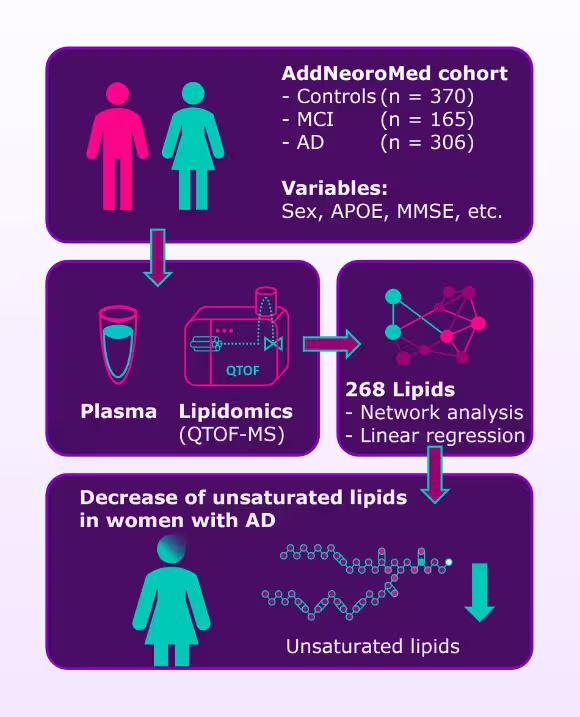4 Minutes
New lipid study links omega-containing fats to lower Alzheimer’s risk in women
A new lipidomics study indicates that specific blood lipids — particularly those containing omega fatty acids — are strongly associated with Alzheimer’s disease (AD) in women but show little or no association in men. Alzheimer’s, a progressive neurodegenerative disorder and the most common cause of dementia, affects tens of millions worldwide and disproportionately impacts women, who represent about two thirds of diagnosed cases.
Study design and methods
Researchers analyzed plasma from 841 adults spanning cognitively healthy controls, people with mild cognitive impairment (MCI), and patients with Alzheimer’s disease. Using high-resolution mass spectrometry, the team profiled roughly 700 individual lipid species and correlated those profiles with clinical measures of brain inflammation and damage. This large-scale lipidomics approach provides a detailed snapshot of circulating lipid chemistry tied to neurodegeneration.
What lipids were involved?
Lipids include many classes of molecules important for cell membranes, energy storage, and signaling. The study separated saturated lipids — generally linked to negative cardiometabolic and inflammatory outcomes — from unsaturated lipids, including mono- and polyunsaturated species that can contain omega-3 and omega-6 fatty acids. Investigators observed a marked rise in saturated lipid species in women with AD versus healthy women, while omega-containing unsaturated lipids were the most depleted in female AD patients.
Key discoveries and sex-specific implications
The most striking finding is the sex specificity: many of the lipid changes correlated with Alzheimer’s were strong in women but absent or negligible in men. According to the study team, this suggests distinct lipid biology between sexes in the context of AD and highlights the potential role of omega fatty acids in female brain health. Lead investigators commented that these differences open new opportunities for prevention and precision therapies targeted by sex.
Researchers caution that association does not prove causation. While the patterns are robust across a large cohort, randomized clinical trials are needed to test whether increasing dietary or supplemental omega-3 intake can alter the trajectory of AD pathology or symptoms in women.

Practical takeaways and next steps
For now, the researchers encourage attention to dietary sources of omega fatty acids — such as fatty fish (salmon, mackerel, sardines), algae-based products, and approved supplements — particularly for women. However, they emphasize the need for clinical trials to determine whether modifying blood lipid composition can truly prevent or slow Alzheimer’s progression.
Expert Insight "These results are compelling because they highlight a measurable, sex-specific biochemical signature that could be targeted early," says Dr. Maya Patel, a fictional neurologist and clinical lipidomics specialist. "If validated in intervention studies, altering omega lipid status might become part of personalized prevention strategies for women at risk of AD." Dr. Patel notes the importance of integrating lipidomics with genetic and imaging data to pinpoint when in life these changes emerge and whether they interact with menopause, hormone status, or lifestyle factors.
Conclusion
This large lipidomics study reveals that women with Alzheimer’s disease exhibit increased saturated lipids and reduced omega-containing unsaturated lipids in blood, a pattern largely absent in men. The findings underscore sex-specific biology in AD, suggest a potential protective role for omega fatty acids in women, and call for clinical trials to test whether dietary or supplemental interventions can influence disease risk or progression. Continued research will determine how early these lipid changes occur and whether they can be used for prevention, diagnosis, or personalized treatment strategies.
Source: sci


Leave a Comment